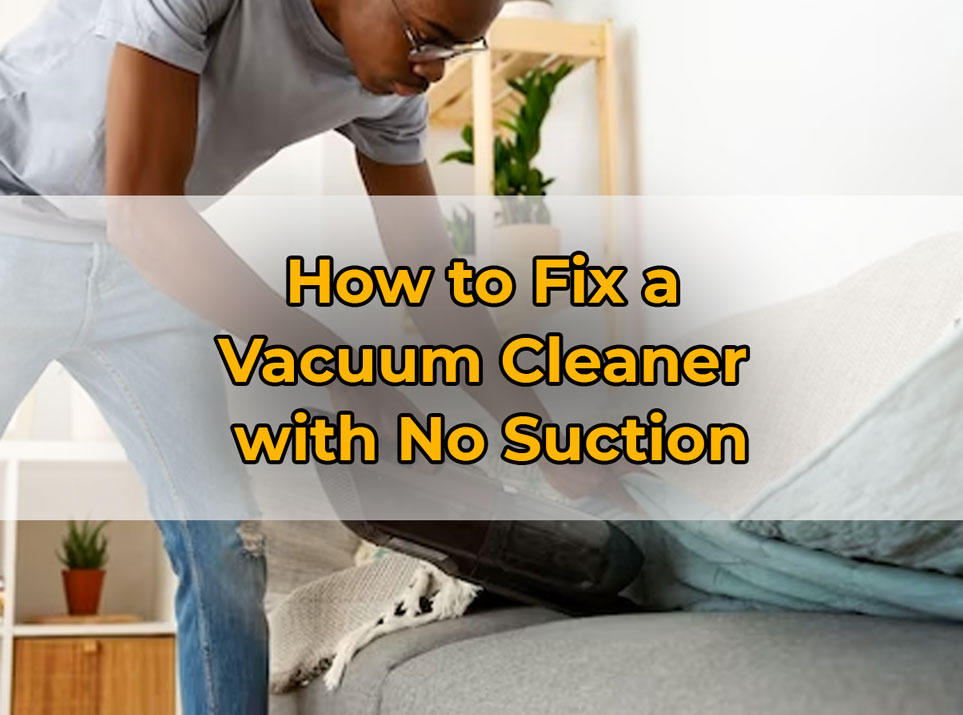Looking on how to fix a vacuum cleaner with no suction? Vacuums are great for keeping your home spic and span, but what if you don’t want it to work properly? Here are a few ways to make your vacuum weak!
Also, if you don’t maintain your vacuum, it can lead to weak suction. Not knowing what your vacuum needs or how to use it properly can also contribute to poor results.
If you don’t take care of these issues, they could lead to bigger problems in the future. So, make sure you remove pet hair and other objects that can block your vacuum tube.
Possible Causes of a Vacuum Cleaner with No suction

Vacuuming is an essential household chore, but when the appliance has weak or no suction, it becomes an ordeal. Understanding the reasons behind a vacuum cleaner with no suction can help resolve this issue quickly and efficiently.
Don’t let a poorly functioning vacuum cleaner affect your daily routine. Address the problem as soon as possible to prevent unhygienic conditions from settling in and causing microbial growth, allergies, and respiratory infections. Act now to ensure that your home is clean and healthy! Check also: Best Cord Free Handheld Vacuum.
A clogged vacuum is like a constipated elephant trying to suck up crumbs.
1. Clogged filters and hoses
No more suction? That’s a bummer! It’s probably due to all that dust and debris clogging up its filters and hoses. Here’s the fix:
- Turn off your vac.
- Locate and remove filters and hoses.
- Clean or replace filters. Use a long tool or coat hanger to remove clogs from the hoses.
Keep up with the cleaning schedule for these parts – ignoring them leads to reduced suction. But don’t overdo it – read the manufacturer’s cleaning and replacement recs to avoid damage.
2. Damaged or worn out belts
My love life was sucked out, just like your vacuum, when a broken motor ruined my romantic weekend getaway. This issue of suction loss is common with vacuums and there are several causes.
- Loose belts – The belt may have come loose, causing it to stop rotating the brush roll.
- Over-stretched belts – Over time, these belts lose their strength.
- Belts with cracks or tears – Constant friction from vacuuming over obstacles such as mats can cause heat to weaken the belt.
It’s important to maintain your vacuum regularly. This helps detect faulty belts early and prevents any major issues.
3. Broken or dysfunctional motors
Your vacuum cleaner can stop suctioning for various reasons. The motor is the heart of the machine and if it’s not working right, the dirt and debris won’t be cleared effectively. Motors can become worn out from regular use or damage. Overheating or overloading can also lead to this issue.
If you think your vacuum has faulty motors, check the filters first. Blocked filters may cause strain on the motor. Also take a look at the hoses and pipes. Long hoses might block suction.
If your vacuum bag is full, it’s not just your carpets getting sucked dry.
4. Faulty vacuum bag or container
Cleaning and vacuuming are essential for home hygiene. But, when you have a vacuum with zero suction, it can be annoying. A possible cause is a faulty vacuum bag or container.
- Defective Bags: A full or damaged bag can clog the airways and impede suction.
- Incompatible Bag: Not all bags are universal. So, buying the wrong one may stop suction.
- Wrong Installation: Incorrectly installing the bag or container can block airflow and cause low suction.
- Damaged Container: Physical damage to the container can reduce your device’s efficiency.
- Clogged Pathway: Dust or dirt buildup between the container/bag and motor can weaken the suction force.
To avoid low suction, pick bags/containers that fit properly and clean the pathways. Using Premium-quality vacuum cleaners can also help- they are more durable and won’t reduce the efficiency of sucking up dirt.
5. Insufficient power supply
Is your vacuum cleaner not suctioning? Maybe its power source isn’t meeting requirements. Check the electrical cord, circuit breaker, or outlet.
Also, clogged filters or dirt cups may reduce suction power. Clean them for optimal performance.
If the motor is worn out, it won’t generate suction pressure. Replace or repair it to get back on track.
Preventive maintenance is key. Inspect your vacuum cleaner regularly and clean filters routinely. Empty the dust cup too. This way, you can avoid costly repairs and enjoy a clean home every time. Check also: Best Above Ground Pool Vacuum.
How to Fix a Vacuum Cleaner with No Suction

When a vacuum cleaner is not picking up debris, it could be a frustrating experience, but with proper troubleshooting, the problem can be resolved. By identifying the root cause, one can fix a vacuum cleaner with no suction.
According to a study by the Environmental Protection Agency, a vacuum cleaner’s efficiency can be improved by up to 50% by following the manufacturer’s maintenance instructions. Cleaning filters and hoses is like trying to unclog a shower drain with a toothpick.
1. Cleaning filters and hoses
When your vacuum’s not performing its best, cleaning its parts like filters and hoses can help. Here’s how to do it:
- First, unplug the vacuum and remove the filter. It may be washable or disposable. If washable, rinse with cold water until clear.
- Detach the hose carefully and check for blockages. Tap it. If blockages persist, try using a long object like a broom handle to dislodge any stuck bits.
- Turn off the machine and examine the other parts of the vacuum for dust build-up. This might affect suction.
- If no apparent faults, but suction still seems off, take the vacuum to a professional for technical investigations.
Make sure all water is drained before re-installing wet filters. This prevents mold and corrosion. Contact customer service if filters aren’t cleaning properly, despite following instructions.
Experiment with lighting if there’s an issue with suction during the day, compared to the night. Finally, give your vacuum a belt replacement to avoid it from going from sucking to sucking at its job! Check also: Best Vacuums Without Beater Bars
2. Replacing belts
When a vacuum cleaner has no suction, understanding how to replace its internal belts is key. Here is a 4-step guide to help you:
- Unplug the vacuum cleaner from its power source.
- Locate and remove the belt cover by undoing screws or levers.
- Carefully remove the old belt. Check for dirt or residues on the brush roller.
- Fit the new belt onto the motor shaft, stretch it over the brush roller, and replace the belt cover.
It’s important to read the manufacturer’s instructions, as different brands and models may require different steps. As an insider tip, check if you can bend the belt over halfway without too much force. If so, it’s time to replace it!
3. Repairing or replacing motors
Is your vacuum not suctioning? Motor issues could be the cause. Replace or fix the motor to restore suction. Motors make vacuums work – they power the suction and brush rotation. Damage to the motor means reduced performance and strange noises. Check for blockages first before replacing it.
Getting a new motor is the best way to get full suction. Make sure the new motor fits your vacuum model. Installing it properly, too, will prevent future damage.
Regular cleaning of filters and maintenance helps avoid expensive motor replacements. Lubricate bearings properly for smooth running and better performance. Hopefully, fixing the vacuum bag won’t suck up all your time!
4. Fixing vacuum bag or container
Vacuum Cleaner Bag or Container Care.
The most common reason a vacuum cleaner doesn’t work is a faulty bag or container. Check for holes, leaks, and tears.
To fix:
- Turn off & unplug the vacuum
- Remove the bag/container & get rid of debris
- Clean & replace the bag. Empty & clean the container if it’s reusable
Not maintaining the bag or container will affect suction power. So, your cleaning won’t be complete.
Pro Tip: Check for wear & tear often so you don’t get any nasty surprises!
5. Checking power supply
Ensuring electrical connectivity is essential for a vacuum’s suction. Methodically focus on Establishing Circuit Connection.
- Check the cord and outlet: Look for damage, unplug and plug another device in to assess.
- Inspect the switch: Open cover plate to trace wires, make sure they’re connected properly.
- Isolate motor: Disassemble engine to search for damaged wiring or particles blocking airflow.
- Examine circuit overload: Low suction may be due to a tripped breaker or circuit overload. Check the home’s circuit box.
Occasionally, pets with long hair necessitate a total vacuum engine replacement. Use genuine replacement indications consistently.
Pro Tip: Don’t use incorrect voltage requirements as that could modify the device’s performance.
If all else fails, just pretend the lack of suction was intentional and begin a new minimalist vacuuming trend.
To keep your vacuum from losing suction, remember to clean filters, untangle brush rolls, and inspect belts. Little problems can become bigger if ignored. And don’t vacuum up a family of raccoons!
Preventing a vacuum cleaner with no suction
Preventing a Loss of Suction in Your Vacuum Cleaner
Vacuum cleaners can lose their suction power over time, making them ineffective at cleaning. To prevent this issue, follow these three steps:
Remember to maintain your vacuum regularly to keep it running smoothly and effectively. A clogged or dirty vacuum can cause damage to the motor and decrease its lifespan.
Regular cleaning and maintenance: the only things that can keep a vacuum cleaner with no suction from becoming a permanent furniture piece in your home.
1. Regular cleaning and maintenance
To make sure your vacuum cleaner works properly, it’s essential to clean and maintain it. Not doing so can make it lose its suction, leaving it useless. Here are three ways to take care of it:
- Empty the dustbin or replace bags regularly to stop them from clogging.
- Follow the manufacturer’s instructions when cleaning the filter.
- Check and clean the hose for any blockages often.
It’s important to note that different vacuums have different maintenance needs, so follow the manufacturer’s instructions. Doing this will help the vacuum last longer and do its job better.
2. Proper use and safety precautions
Using a vacuum cleaner requires following safety measures. To ensure good cleaning performance and a long life, one must understand and abide by the proper use and security guidelines.
- Keep the bag or canister clean and unclogged for strong suction power.
- To stay safe, don’t twist or tangle the cord while vacuuming.
- Always use a filter, or else irreparable harm to the motor and other pieces could occur.
- Never run the vacuum near flammable liquids or gases or an open flame.
- To keep it working well, clean the filters, remove blockages from brush rolls, avoid bigger dirt particles going into hoses and maintain belts tension for smooth brush roll rotation.
- Store the vacuum in a dry place, otherwise internal components may be flooded and ruined.
3. Quality and durability of vacuum cleaner parts
High-quality components are essential for a functional vacuum cleaner. Low-grade parts can reduce suction and cause poor performance. It’s wise to invest in long-lasting, resilient components. Inspect them regularly for damage and wear.
To keep your vacuum running smoothly, clean the HEPA filter, remove hair from the brush roll, and inspect the hose for blockages. Don’t use harsh chemicals on plastic or rubber materials. For any vacuuming repairs, let experts handle it. I’d just end up sucking up the screws if I tried to do it myself!
4. Professional servicing and repairs
Maintaining & repairing household appliances by experts is the best way to prevent issues. Skilled servicing & repairs done by professionals can save you both time & money. Entrusting repairs to electricians or technicians experienced in solving common problems with minor appliances will help avoid costly DIY mistakes.
Regular checkups & maintenance schedules help minimize the need for major repairs, resulting in a longer lifespan for the appliance. Professional servicing also ensures optimum performance levels, reducing energy consumption. Even if an appliance looks problem-free & running smoothly, it’s best to get annual servicing by a specialist as a preventative measure.
Neglecting minor technical difficulties or not following cleaning instructions in appliance manuals can lead to faulty equipment or unwanted repairs. To avoid this, prioritize routine maintenance.
Conclusion: Ensuring optimal suction power for your vacuum cleaner.
Maximizing your vacuum cleaner’s suction power is key. Here are some tips to help you do so:
- Keep filters clean and replace regularly.
- Check hoses and tubes for blockages or leaks.
- Make sure the power cord is good and the outlet supplies enough power.
Referring to the product manual is important to determine the ideal suction power range for your vacuum cleaner.
For optimum cleaning of carpets, also adjust the nozzle height correctly. This prevents harm to carpet fibers, and helps capture dust particles.
How do I unclog a vacuum cleaner filter?
Check the manufacturer’s instructions for your specific model, but generally, you can remove the filter and tap it to dislodge any trapped debris. You may also need to wash the filter with water and allow it to dry completely before replacing it.
What should I do if my vacuum cleaner hose is clogged?
Use a long, thin object like a broom handle or coat hanger to gently push the clog through the hose. Alternatively, you can detach the hose from the vacuum and use a power nozzle or compressed air to blow out the blockage.
How do I know if my vacuum cleaner belt is broken?
If your vacuum cleaner is not picking up dirt and the brush roll is not turning, it is likely a broken belt. You can check the belt by turning off the vacuum and unplugging it, then looking for signs of wear or damage on the belt.
Can a vacuum cleaner motor be repaired?
In some cases, a malfunctioning vacuum cleaner motor can be repaired by a professional. However, it may be more cost-effective to replace the motor or the entire vacuum cleaner.
How often should I replace my vacuum cleaner filter?
This depends on the model and frequency of use, but generally, it is recommended to replace the filter every 3-6 months. Consult your manufacturer’s instructions for specific recommendations.
“There is no real ending. It’s just the place where you stop the story.”






